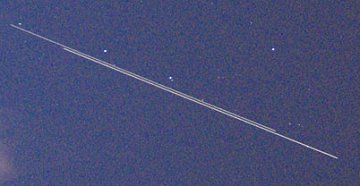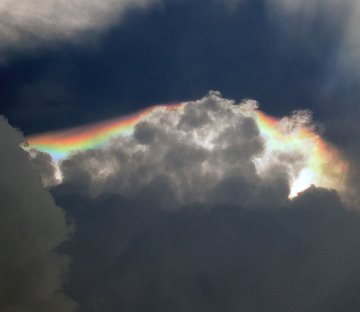 Where's Saturn? Is that a UFO--or the ISS? What's the name of that star? Get the answers from mySKY--a fun new astronomy helper from Meade. Where's Saturn? Is that a UFO--or the ISS? What's the name of that star? Get the answers from mySKY--a fun new astronomy helper from Meade. NOCTILUCENT CLOUDS: Last night, sky watchers in Oregon and Washington witnessed a bright display of noctilucent clouds (NLCs). "We were waiting for the space shuttle and ISS to fly over Portland when we saw them," reports Bridget E. Smith. The electric blue clouds were nearly as bright as Venus--see this photo from Wade B. Clark Jr. of Lyman, Washington. While Europeans have seen many NLCs in recent weeks, this marks the first good apparition of 2007 for observers in the United States. Stay tuned for more photos. SPACESHIP SIGHTINGS: Space shuttle Atlantis and the ISS have undocked and they are now orbiting Earth in tandem. Last night Norm Klekoda took this picture when the duo flew over Grand Rapids, Michigan: 
Photo details: Canon Powershot SD400, 15 sec. exposure
"They were nicely separated--about one finger width at arm's length," he says. "Beautiful!" Atlantis is moving away from the space station as it prepares to return to Earth on Thursday, but the two ships will still be fairly close together tonight when they once again fly over many US towns and cities. The shuttle is the white one, while the ISS has an orange tint, which it gets from its ruddy solar panels. When should you look? There are two ways to find out: Sign up for flyby alerts from Spaceweather PHONE or check the flyby time tables at Heavens Above. more images: from John Kirchhoff of Hudson, Michigan; from Tony Wilder of Chippewa Falls, Wisconsin. IRIDESCENT THUNDERHEAD: "On June 18th, more than 100 people attending the Heart of America Star Party near Butler, Missouri, watched a beautiful display of iridescent clouds," reports photographer Tom J. Martinez. Iridescent clouds are common enough, but these were strange because "they were riding on top of a thunderhead." 
"This is an iridescent pileus cloud," explains atmospheric optics expert Les Cowley. "On sunny afternoons, cumulus clouds boil upwards, pushing layers of moist air above them even higher where they cool and condense to form cloud caps or 'pileus' (Latin for cap). Pileus clouds formed very quickly have their water droplets all the same size--the perfect condition for iridescent colors." "The colors came and went as the cloud changed shape," notes Martinez. More images: #1, #2, #3
Eclipse of Venus Photo Gallery
Updated June 19, 2007 | 
